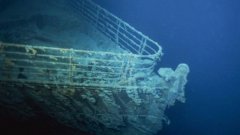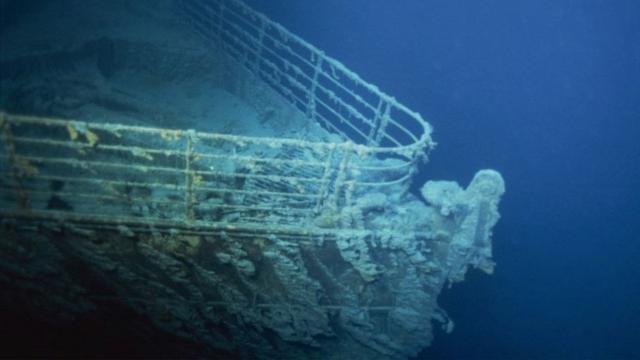
The "Titanic" (RMS Titanic (Titani) shipwreck has spent 112 years in the deep sea.
In April 1912, the huge wheel of 883 feet (269 meters) broke and sank in a cold and dark night.EssenceMore than 1,500 passengers and crew members were killed in the accident.
In addition to the occasional deep -sea submersible and salvage team visit, bring some small cultural relics back to the sea surface, the wreckage of Titanic almost retains the original state, and slowly and stable rotten.
Titanic wreckage is located nearly 400 miles (640 kilometers) southeast of Newfoundland's coast.The image obtained recently revealed the continuous corruption of the wreckage.Since the discovery of the Titanic wreckage in 1985, the hull and its unique railings in the darkness have become the iconic landscape.However, in 2022, the scanning railing of the shipwreck showed that the railing began to bend, and when the wreckage visited the wreckage in 2024, a large part of the railing had fallen off.
This is very intuitive that the extreme environment in the depths of the ocean is fragmented by the wreckage of the world's most famous ships.The pressure, sea flow and iron food bacteria above it are leading to the collapse of the ship's structure.At the same time, the ship also had a surprising impact on the surrounding marine ecological environment.
Under pressure
When the Titanic sinks, it is divided into two main parts -the bow and stern.The stern part is directly sinking into the bottom of the sea, and the bow is sinking slowly.These two parts are nearly 2000 feet (600 meters) from the bottom of the sea.
From the stern to the bow of the ship more than 1.3 miles (2 kilometers), there are various items, accessories, fixed facilities, coal and hull components.Most of the wreckage is concentrated on the stern part, where it is a distorted steel, and the bow is basically intact.
This is because when the Titanic hit the iceberg, the impact force tore the riveting part of the hull, so that about 43,000 tons of seawater poured into the bow.When the stern part is broken, it still has a cabin full of air.When it suddenly sinks into the bottom of the sea, the rapidly increased water pressure caused the structure around these airbags to explode, and the metal, statues, champagne wine bottles and passengers' property were fractured.
On the sea bed, the water pressure suffered by the Titanic is about 40 MPa, which is 390 times the water pressure of the sea surface.However, because there are no airbags in the ship, it is unlikely that further disaster explosion occurs.
On the contrary, the weight of the giant wheel itself is playing a certain role in its death.When 5.2 tons of steel sink into the bottom of the sea, it has a twisted steel hull and tears the hull.In continuous diving operations, people saw huge cracks and cracks on the hull steel plate, and the deck area has been collapsed inward.
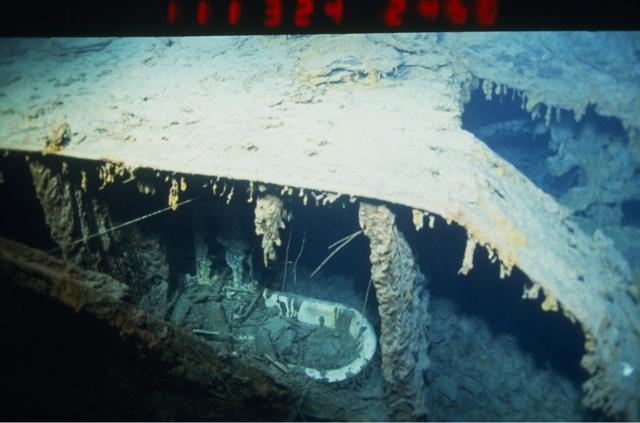
"The iconic outline of shipwrecks will change year by year -and it is not a good change." Said Gerhard Seifert, a deep -sea archeologist.In 2022, Savert and Magellan, a deep -sea surveying and mapping company, led the expedition to the expedition to scan the Titanic wreckage.
"In 2022, when Magellan and I inspected the Wreckage of Titanic, the drops of the drops were still in the same place. A few years ago, the collapse of the captain's bathroom ceiling may also be an example." He said.
Sever said that as the steel plates, beams, and other load -bearing components became thinner and thinner due to corrosion, the structure of the ship is increasingly weakened.
Devouring by bacteria
Like other steel structures, the Titanic is also rusty.However, in the 2.4 miles (3.8 kilometers) deep seawater, the rust process is different from the land. On land, oxygen and water will trigger chemical reactions to produce iron oxide.On the Titanic, most corrosion is caused by bacteria.
A layer of biofilm is covered on the ship, which is a "live blanket" composed of bacteria, marine fungi and other microorganisms. They eat the shipwreck itself.Initially, organic materials such as interior decoration, pillows, towels, and furniture provided rich nutrition for microorganisms drifting in the depths of the ocean and set them to settle.
Over time, other more extreme microorganisms also occupy a place.They may be sown when the shipbuilding is hit by the bottom of the sea, or it may be drifted from the sea bottom hot spring from the distant Atlantic ridge.
The surface of the hull is eroded by various bacteria of iron oxide and bacteria that produce acidic substances.There are also other microorganisms on the shipbuilding, and they specifically devour the rust produced by these bacteria.
Researchers visiting the shipwreck noticed that a layer of "rust" was covered on the shipwreck -an ice -cylindrical substance hanging on the oxide metal structure.In these substances, there are many microorganisms that cooperate and compete with each other.In 1991, when scientists at the "Akademic MSTISLAV Keldysh) inspected the Titanic wreckage, one of the" rust pillars "was broken and packed them in a sealed containerBack to the sea.
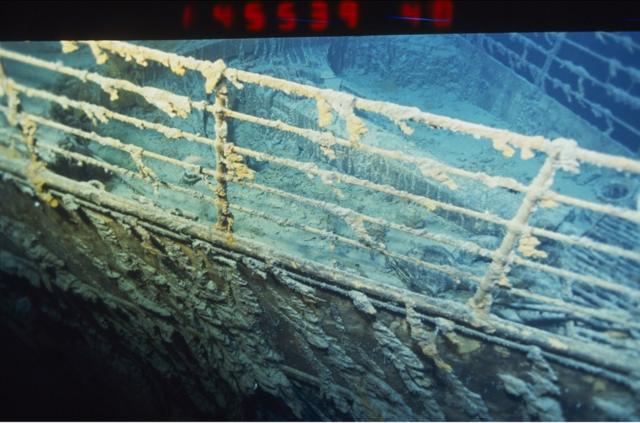
Among the microorganisms discovered by the researchers, there is a bacteria found on the shipwreck. At that time, it was brand new for scientists.This bacteria was later named "Halomonas Titanicae", which carries genes that can break down iron.
The sulfate also infiltrates the area without oxygen, such as a small gap produced when the structure is bent.These bacteria will produce sulfur, which translates into sulfuric acid in seawater, and then corrodes the hull metal to release other microorganisms from the iron supply.
Scientists believe that the stern has accumulated a greater degree of damage during the fall, which has led to 40 years faster than the vessel part of the bow.
"This is why the bow of the Titanic hull began to rot more from the stern part, because the ship was broken here, and rotten was promoted to the bow or the front area, because it was relatively intact there."Anthony El-Khouri, a microbiologist at the East Florida College, explained.El Curry has been working with Canadian film director and deep-sea explorer James Cameron to understand how microorganisms are rotten by Titanic.
"In addition to the comprehensive engine, fan tail, rudder rudder and pusher, it can be identified to a certain extent.Er Curry said.
Cameron inspected the Titanic ship in 2005, and found a strange feature in the Turkish bathroom, which was a delicate and delicate rust scroll that formed. The director named it "Rust flower ".
He used the remote control submersible to find that because the bathroom was in the depths of the hull and had no oxygen, the teak and mahogany products in the bath were extremely well preserved, because this hypoxic environment prevented the bacteria and other microorganisms that might degrade wood and other microorganisms that might degrade wood and other microorganisms.Survive here.
But on the contrary, the bath is full of rusty rust, from the floor of the bath to 1.5 meters (5 feet) from the bath.Surprisingly, these "rust flowers" seem to point to the same direction -geomagnetic line.EthicsEr Curry, Cameron and their colleagues found some clues, indicating that they were formed by rusty bacteria and "magnetic" bacterial communities living on the ship.These unusual microorganisms contain iron nano crystals, so that they can be consistent with the magnetic field.El Curry said that when these bacterial groups eat the steel of the Titanic, they will leave rust and "bloom" along the magnetic force line of the earth.
The rich "iron meal"
Titanic brought a large amount of iron -rich metals into the bottom of the sea, creating an unusual ecosystem around it.As it is corroded, iron particles are dissolved into the surrounding seawater, providing scarce but important nutrients in the deep sea.
"Although iron is the most common element on the planet, dissolved iron is the rare nutrient in the ocean, which limits the success of any marine ecosystem." El Curry said.The hot spring underwater is usually the main source of iron in the deep sea, which can help support a variety of lives. Among them, bacteria play an important role in providing iron in other creatures near them.
"The wreckage of the Titanic is essentially like a huge iron oasis on the sea floor. It is an iron compression body weighing 46,000 tons and shaped like an former luxury cruise ship." El Curry said."This oasis provides mouth -watering nutrients and promotes the formation of vibrant deep -sea coral reefs. Stars, anemia, glass sponge, bottom corals, and sea cucumbers all inhabit. Of course, there are iron bacterial colonies."He said.
El Curry and his colleagues found that these bacteria related to iron not only eat the iron on the Titanic, but also "can also breathe by iron", not oxygen.
"This is an extraordinary ecosystem far from the sun. It is of great significance to have the kind of polarized creatures found in the ocean of the universe in Muwei Er and the earth." He said.
The iron of the Titanic also affects the bottom of the sea.The rust flowing is about 4 inches (10 cm) per year, and the shipwreck spreads outward from the shipping, and extends to 6 inches (15 cm) in the sediment.These iron rust flows are particularly concentrated around the stern.
According to scientists, the Titanic lost about 0.13 to 0.2 tons of iron from its rust structure every day.Therefore, some people estimate that the iron at the bow may be completely dissolved within 280-420.
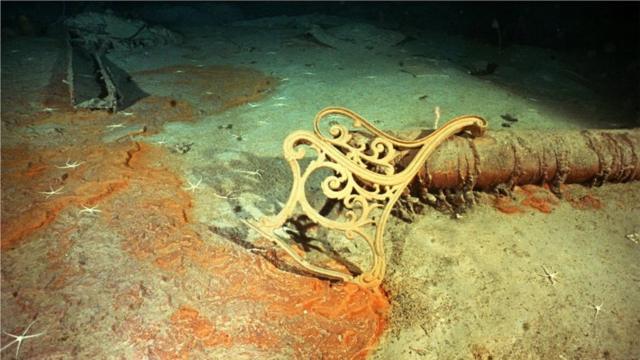
Underwater Ocean flow
But other factors may also accelerate the destruction of shipwrecks.Just as the strong sea flow will cause the ship and the swimmer to deviate from the channel, the deep sea will also be washed by underwater flow.Although the deep ocean flow is not as powerful as the ocean flow on the sea, it also affects a large amount of seawater.
Deep ocean flow may be driven by the sea surface wind, deep water tide or the water density difference (referred to as the temperature salt circulation) caused by temperature and salinity.The rare event (usually related to the eddy current of the sea), known as the "underwater storm", also causes a strong and sporadic current, thereby rolling away the bottom of the sea.
The research of scientists' research on the sedimentary form on the sea bed around the Titanic and the movement of squid around the shipwreck, to understand how the Titanic is impacted by the underwater flow.
It is understood that some of the wreckage of the Titanic shipwreck is located near the sea bed affected by a cold water flowing south. This water flow is called "western border potential".This "bottom flow" forms moving sand dunes, ripples and strip -like patterns in the sediment and mud.Most of the formations they observed at the bottom of the sea are related to relatively weak to medium ocean currents.
The sand pattern on the edge of the eastern edge of the wreckage area of the Titanic also indicates that there is an ocean current westward, and in the main wreckage area, the trend of the ocean flow is from northwest to southwest. This may be due to the large wreckage.The fragments changed their direction.
South of the bow, the current flow seems to be particularly changing, from northeast to northwest to southwest.
Although these ocean currents are not particularly strong, they will still cause interference, causing the shipwreck to break when it becomes fragile.
"Even the water generated by a submersible can cause a weak structural collapse," Savert said."However, they may (also) to remove some rust, thereby delay the corrosion of these areas."
In addition, under the shuttle of these ocean flow, the wreckage of the Titanic may be buried under the sediment before fully decomposing.
But before that, some of the more iconic parts in the hull wreckage may disappear, just like the recent collapsed hull guardrail. In the Titanic movie filmed by Cameron in 1997, the protagonist Jack (Jack) The scene of Rose standing behind the head guardrail became a classic.
"I estimate that the more iconic areas on the shipping ship, such as the upper building -the ladder hall, Marcii room, and officer dormitory -will disappear around 2100, which will make the submersible land on the TitanicMore challenging. "El Curry said."Sub -thin steel disappeared earlier, such as railings and deck rooms on the deck. But even according to such a rotten speed, the shipwreck needs a few centuries to completely disappear."
Large steel buried in the sediment is protected, and it will not be severely damaged by microorganisms of the metal of the snake, so it can be stored longer.According to El Curry estimates, it may be preserved for hundreds of years.
But what are the final fate of this world's most famous shipwreck?It is a trace of iron oxide on the sea bed, which is covered with tiles, toilets and brass accessories.
"Ceramic products, such as the bright tiles in the Turkish bathroom, are composed of burned silicon, which can almost be existed forever." El Curry said.
The Titanic will eventually become a very inconspicuous monument to commemorate a tragedy caused by human arrogance and defects.But maybe, this is also a beautiful and calm end of this vicissitudes of giant wheels.


